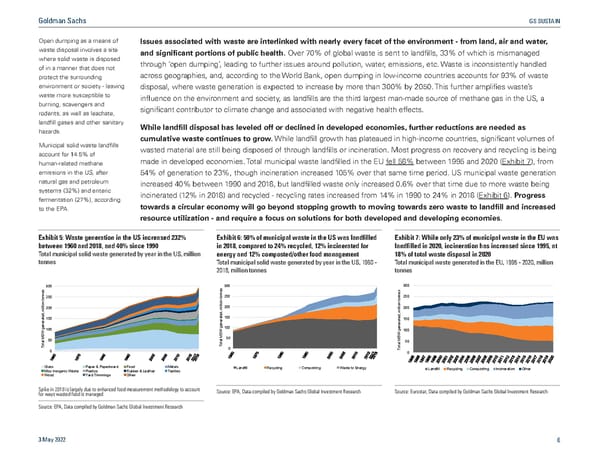Goldman Sachs GS SUSTAIN Open dumping as a means of Issues associated with waste are interlinked with nearly every facet of the environment - from land, air and water, waste disposal involves a site and significant portions of public health. Over 70% of global waste is sent to landfills, 33% of which is mismanaged where solid waste is disposed through ‘open dumping’, leading to further issues around pollution, water, emissions, etc. Waste is inconsistently handled of in a manner that does not protect the surrounding across geographies, and, according to the World Bank, open dumping in low-income countries accounts for 93% of waste environment or society - leaving disposal, where waste generation is expected to increase by more than 300% by 2050. This further amplifies waste’s waste more susceptible to influence on the environment and society, as landfills are the third largest man-made source of methane gas in the US, a burning, scavengers and significant contributor to climate change and associated with negative health effects. rodents, as well as leachate, landfill gases and other sanitary While landfill disposal has leveled off or declined in developed economies, further reductions are needed as hazards. cumulative waste continues to grow. While landfill growth has plateaued in high-income countries, significant volumes of Municipal solid waste landfills wasted material are still being disposed of through landfills or incineration. Most progress on recovery and recycling is being account for 14.5% of made in developed economies. Total municipal waste landfilled in the EU fell 58% human-related methane between 1995 and 2020 (Exhibit 7), from emissions in the US, after 54% of generation to 23%, though incineration increased 105% over that same time period. US municipal waste generation natural gas and petroleum increased 40% between 1990 and 2018, but landfilled waste only increased 0.6% over that time due to more waste being systems (32%) and enteric incinerated (12% in 2018) and recycled - recycling rates increased from 14% in 1990 to 24% in 2018 (Exhibit 6). Progress fermentation (27%), according to the EPA. towards a circular economy will go beyond stopping growth to moving towards zero waste to landfill and increased resource utilization - and require a focus on solutions for both developed and developing economies. Exhibit 5: Waste generation in the US increased 232% Exhibit 6: 50% of municipal waste in the US was landfilled Exhibit 7: While only 23% of municipal waste in the EU was between 1960 and 2018, and 40% since 1990 in 2018, compared to 24% recycled, 12% incinerated for landfilled in 2020, incineration has increased since 1995, at Total municipal solid waste generated by year in the US, million energy and 12% composted/other food management 18% of total waste disposal in 2020 tonnes Total municipal solid waste generated by year in the US, 1960 - Total municipal waste generated in the EU, 1995 - 2020, million 2018, million tonnes tonnes 300 300 300 tonnes250 tonnes250 onnes250 t million 200 million 200 illion 200 m 150 150 150 generated, generated, 100 100 generated, 100 W SW S W 50 50 S otal M otal M tal M50 T T 0 o 0 T 0 Glass Paper & Paperboard Food Metals Landfill Recycling Composting Waste to Energy Landfill Recycling Composting Incineration Other Misc Inorganic Waste Plastics Rubber & Leather Textiles Wood Yard Trimmings Other Spike in 2018 is largely due to enhanced food measurement methodology to account Source: EPA, Data compiled by Goldman Sachs Global Investment Research Source: Eurostat, Data compiled by Goldman Sachs Global Investment Research for ways wasted food is managed. Source: EPA, Data compiled by Goldman Sachs Global Investment Research 3 May 2022 6
 GS SUSTAIN: Circular Economy Report Page 6 Page 8
GS SUSTAIN: Circular Economy Report Page 6 Page 8